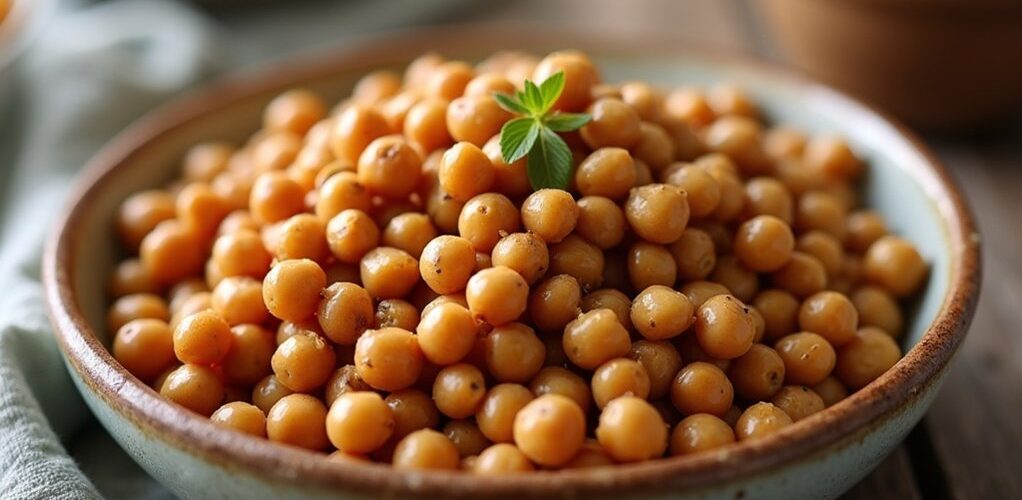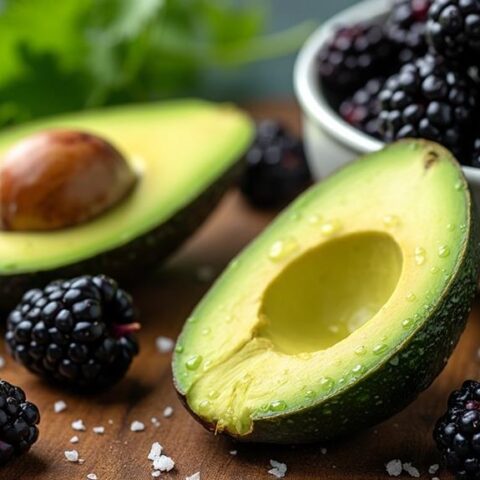
Black-eyed peas aren't considered low-carb, containing 27 grams of net carbs per cup after accounting for fiber. While cherished in Southern cuisine and traditionally eaten for good luck on New Year's Day, these legumes require careful portion control on low-carb diets. Their high fiber content and protein help moderate blood sugar impact, making half-cup servings manageable for some low-carb dieters. Understanding preparation methods and exploring alternatives can help maintain Southern cooking traditions while managing carbohydrate intake.
Key Takeaways
- Black-eyed peas contain 27 grams of net carbs per cup, making them relatively high in carbohydrates for strict low-carb diets.
- A half-cup serving provides 17 grams of net carbs, allowing incorporation into flexible low-carb diets with careful portion control.
- Their high fiber content (8 grams per cup) and protein help slow digestion, making them suitable for blood sugar management.
- Low-carb alternatives include green beans, black soybeans, and edamame, offering similar textures with significantly fewer carbohydrates.
- Traditional preparation methods like overnight soaking can reduce cooking time and help minimize the impact on blood sugar levels.
Understanding Black-Eyed Peas and Their Cultural Significance
While black-eyed peas have become a beloved staple in many cuisines worldwide, their journey to prominence began in Africa before making their way to the Americas through the West Indies in the late 17th century.
These legumes quickly established themselves as a cornerstone of Southern cuisine, particularly gaining cultural significance in African-American traditions where they symbolize unity and shared prosperity during family gatherings.
Perhaps most significantly, black-eyed peas feature prominently in the classic Southern dish Hoppin' John, traditionally consumed on New Year's Day for good luck.
This practice stems from the belief that these high protein, fiber-rich legumes represent coins, promising wealth and prosperity for the coming year.
As a dietary staple, black-eyed peas continue to bridge cultural traditions while providing essential nutrition across diverse communities.
The Carbohydrate Content of Black-Eyed Peas
The carbohydrate profile of black-eyed peas presents important considerations for individuals following low-carb dietary plans. With approximately 35 grams of total carbohydrates per cup, including 8 grams of dietary fiber, these legumes contain 27 grams of net carbs per serving.
While their high carbohydrate count makes them challenging to incorporate into a strict ketogenic diet, which typically limits daily carb intake to 20-50 grams, black-eyed peas can be included in more flexible low-carb diets when properly portioned.
Despite their carbohydrate content, these legumes offer significant health benefits through their protein content of 13 grams per cup and essential nutrients. For those following a less restrictive low-carb approach, black-eyed peas can be enjoyed in moderation while still maintaining dietary goals.
Black-Eyed Peas and Blood Sugar Response
Black-eyed peas offer notable benefits for blood sugar management due to their relatively low glycemic index, which results in a more gradual rise in glucose levels after consumption.
The combination of fiber and protein in black-eyed peas works synergistically to slow digestion and moderate carbohydrate absorption, making them a smart choice for those monitoring their blood sugar levels.
Despite containing 27 grams of net carbs per cup, black-eyed peas can be incorporated into a flexible low-carb eating plan, as their nutritional composition helps prevent the sharp blood sugar spikes often associated with higher glycemic foods.
Glycemic Index Impact
Many people seeking better blood sugar control will find black-eyed peas to be an excellent dietary choice, thanks to their particularly low glycemic index and balanced nutritional profile.
With just 27 grams of net carbs per cup and significant amounts of fiber and protein, these legumes promote steady digestion and help maintain stable blood sugar levels throughout the day.
Key benefits of black-eyed peas' glycemic impact include:
- Slow-digesting carbohydrates that prevent rapid blood sugar spikes
- Combined effects of fiber and protein that enhance satiety and digestive health
- Natural nutritional composition that supports sustained energy release
The low glycemic index of black-eyed peas, coupled with their fiber content and protein levels, makes them a smart choice for those monitoring their blood sugar response while seeking nutritional benefits.
Managing Blood Sugar Levels
Understanding how black-eyed peas affect blood sugar levels can greatly impact dietary choices for those managing diabetes or general metabolic health. This southern food favorite demonstrates favorable characteristics for glucose management, containing 27 grams of net carbs per cup while offering substantial fiber and protein content.
| Component | Blood Sugar Impact |
|---|---|
| Fiber | Slows carb absorption |
| Net Carbs | Moderate at 27g/cup |
| Glycemic Index | Low, gradual release |
The combination of complex carbohydrates and fiber in black-eyed peas contributes to their low glycemic index rating, making them a smart choice for managing blood sugar levels. When incorporated into balanced meals, these legumes help maintain steady glucose levels while providing sustained energy, particularly beneficial for individuals monitoring diabetes or seeking better metabolic control.
Net Carbs vs. Total Carbs in Black-Eyed Peas
While black-eyed peas contain 35 grams of total carbohydrates per cup, understanding their net carb content requires subtracting the 8 grams of dietary fiber, resulting in 27 grams of net carbs.
This calculation becomes essential for individuals tracking their carbohydrate intake, particularly those following specific dietary protocols like ketogenic or low-carb plans.
The significant difference between total and net carbs in black-eyed peas highlights the importance of accurate macro tracking, as these legumes can quickly consume a substantial portion of one's daily carbohydrate allowance.
Understanding Net Carb Math
When calculating the carbohydrate content of black-eyed peas for a low-carb diet, the distinction between total carbs and net carbs becomes essential for accurate meal planning.
The math is straightforward: a cup of black-eyed peas contains 35 grams of total carbohydrates, including 8 grams of dietary fiber. By subtracting the fiber from total carbs, the net carb count equals 27 grams per cup.
- One cup serving = 35g total carbohydrates – 8g dietary fiber = 27g net carbs
- Net carbs impact blood sugar levels and ketosis, while fiber does not
- Daily net carb limit on ketogenic diet: 20-50g total
For those following low-carb or ketogenic diets, understanding these calculations helps maintain proper portion control while still enjoying the nutritional benefits of black-eyed peas within their daily net carb limits.
Daily Macros Impact Analysis
The impact of black-eyed peas on daily macronutrient goals requires careful consideration for those following low-carb dietary protocols. With 27 grams of net carbs per cup, black-eyed peas can consume a significant portion of the daily net carb allowance, particularly for those following a strict ketogenic diet limiting intake to 20-50 grams.
Despite their carbohydrate content, these legumes offer valuable nutritional benefits as a source of fiber and protein, while their low glycemic index supports stable blood sugar levels.
For individuals following a more flexible low-carb diet, portion control becomes essential. By carefully measuring servings and adjusting other daily carbohydrate intake accordingly, black-eyed peas can be incorporated into a low-carb eating plan while maintaining overall macro targets.
Low-Carb Alternatives to Black-Eyed Peas
For individuals following a low-carb diet, several nutritious alternatives to black-eyed peas can provide similar textures and flavors while maintaining dietary goals.
Green beans offer a crunchy option with just 7 grams of net carbs per 100 grams, while black soybeans contain merely 2 grams. Edamame and cauliflower present versatile alternatives, containing 4 and 3 grams of net carbs respectively, making them excellent substitutes in traditional recipes.
- Black soybeans maintain a similar texture and flavor profile, making them perfect for soups and stews.
- Cauliflower can be transformed into rice, purees, or used as a filling substitute.
- Green beans provide a satisfying crunch in salads and side dishes.
Incorporating non-starchy vegetables like cauliflower can enhance nutrient intake while keeping carb counts low. When implementing these alternatives, adjusting cooking times and seasonings guarantees ideal results while maintaining the integrity of the original dish.
Incorporating Black-Eyed Peas Into a Low-Carb Lifestyle
Many individuals following a low-carb lifestyle can successfully incorporate black-eyed peas into their meal plans through mindful portion control and strategic meal timing. With 27 grams of net carbs per cup, these legumes require careful management, particularly for those on strict low-carb diets. However, their ability to stabilize blood sugar and provide substantial nutritional benefits, including 13 grams of protein per serving, makes them worth considering in moderation. To effectively include black-eyed peas while maintaining lower carbohydrate counts, consumers should measure portion sizes carefully and balance them with low-carb alternatives throughout the day. Those following more restricted eating plans might consider substituting with options like green beans or black soybeans, which offer similar textures while keeping daily carbohydrate intake within desired ranges. Additionally, understanding net carbs is crucial to track carbohydrate intake accurately and maintain ketosis while incorporating foods like black-eyed peas.
Health Benefits Beyond the Carb Count
While carbohydrate content often dominates discussions about black-eyed peas, these versatile legumes offer an impressive array of health benefits that extend far beyond their carb count. Their low glycemic index makes them an excellent choice for blood sugar management, while their high protein content supports muscle maintenance and promotes satiety.
Rich in dietary fiber, black-eyed peas aid digestion and help stabilize blood sugar levels throughout the day.
- Contains essential nutrients like folate and potassium, supporting overall health and wellness
- Provides approximately 13 grams of protein per cup, promoting muscle growth and maintenance
- Rich in antioxidant flavonoids that help combat oxidative stress and reduce chronic disease risk
Additionally, improved insulin sensitivity is a significant benefit for those managing their blood sugar levels, making black-eyed peas a valuable addition to any diet, regardless of their carbohydrate content. These nutritional attributes make black-eyed peas a valuable addition to any diet, regardless of their carbohydrate content.
Tips for Portion Control and Serving Suggestions
Successfully managing black-eyed peas in a low-carb diet requires thoughtful portion control and creative serving strategies. A recommended serving of half a cup contains 17 grams of net carbs, making it essential to plan portions carefully for healthy meals. To optimize carbohydrate intake, combine black-eyed peas with fiber-rich collard greens or other low-carb vegetables, which helps balance blood sugar levels while adding nutritional variety. Non-starchy vegetables like cauliflower and broccoli are excellent alternatives to high-carb options and can be paired with black-eyed peas for a more balanced meal. For enhanced meal balance, incorporate protein sources such as grilled chicken or turkey alongside black-eyed peas. Consider using these legumes as a side dish rather than a main component, or integrate them into mixed dishes like salads seasoned with vegetable broth. This approach allows for better distribution of carbs while maintaining the satisfying qualities of this Southern staple.
Smart Preparation Methods for Reduced Carb Impact
Through strategic preparation methods, cooks can greatly reduce the carbohydrate impact of black-eyed peas without sacrificing their nutritional benefits. Soaking black-eyed peas overnight helps minimize cooking time while potentially lowering their effect on blood sugar levels.
When cooking black-eyed peas, incorporating protein-rich ingredients and high-fiber vegetables creates a more balanced Southern favorite that moderates the net carb impact.
- Combine black-eyed peas with lean meats and colorful vegetables to balance carbohydrate load
- Enhanced flavoring with spices and herbs maintains taste without adding extra carbs
- Consider substituting traditional recipes with lower-carb alternatives like black soybeans when appropriate
These preparation techniques allow for the enjoyment of these classic legumes while maintaining better control over carbohydrate intake, making them more suitable for various dietary needs.
Frequently Asked Questions
Can I Eat Black-Eyed Peas on a Low Carb Diet?
Black-eyed peas can fit into moderate low-carb diets when carefully portioned, offering fiber and protein benefits. However, at 27 net carbs per cup, strict low-carb dieters should consider lower-carb Southern alternatives.
Why Do Southern People Eat Black-Eyed Peas?
Southern traditions embrace black-eyed peas, especially as a New Year's custom symbolizing prosperity and good fortune. Their historical roots in soul food culture and agricultural heritage make them central to family gatherings.
Are Black-Eyed Peas Full of Carbohydrates?
Black-eyed peas contain significant carbohydrates, with 35 grams per cup serving. While their nutritional profile includes beneficial fiber content and protein levels, portion control remains important for those monitoring carbohydrate intake.
What Is the Number One Carb to Avoid?
When carb counting and meal planning, refined sugar stands as the number one carb to avoid, especially for ketone diet followers. Focusing on high fiber alternatives helps maintain stable blood sugar levels.
Conclusion
While black-eyed peas contain more carbohydrates than typical low-carb foods, they can still be part of a balanced diet when consumed mindfully. Their rich nutritional profile, including fiber, protein, and essential minerals, makes them a valuable addition to meals despite their moderate carb content. Through proper portion control, preparation methods, and pairing with low-carb ingredients, individuals can enjoy this Southern staple while maintaining their dietary goals.










No Comments